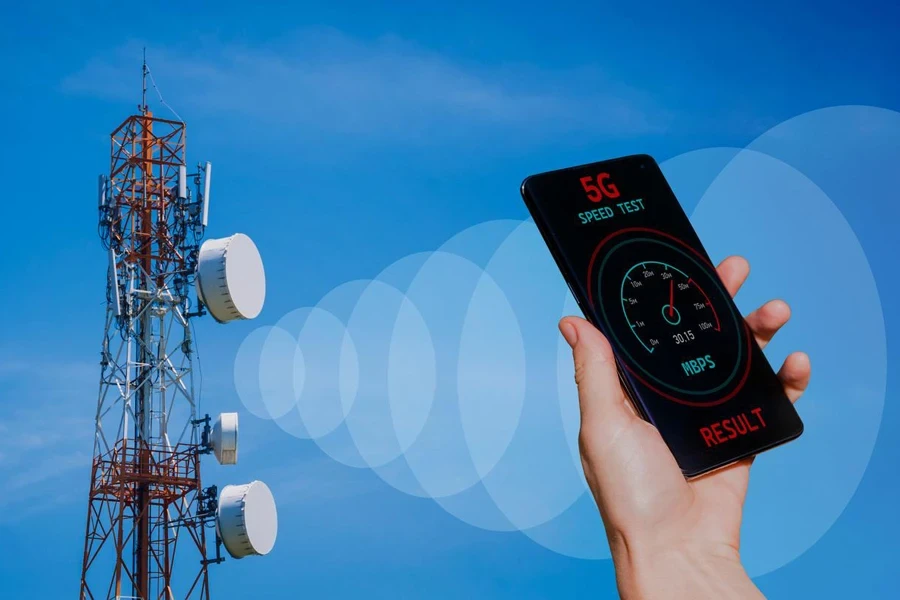Signal booster antennas are critical for seamless connectivity in today’s network-driven environments. They amplify and extend signal strength, ensuring consistent and reliable communication even in challenging locations.
In 2025, advancements in antenna technology cater to a wide array of needs, from industrial applications demanding robust, high-gain solutions to compact models suited for urban settings and 5G networks. Selecting the right antenna maximizes signal quality, minimizes downtime, and supports efficient data transfer, making it a strategic investment in modern, network-intensive operations.
Table of Contents
1. Key types of signal booster antenna and their applications
2. Insights on the current market trends
3. Essential factors for selecting the right antenna
4. Leading models and their standout features
5. Conclusion
Key Types of Signal Booster Antenna and Their Applications

External Antennas
External antennas are essential for enhancing connectivity in areas with limited indoor signal reception. These antennas, often mounted on rooftops or exterior walls, improve connectivity by capturing stronger signals from distant towers, which can be critical for remote or signal-obstructed areas. External antennas are especially valuable for large facilities or rural settings, where high-gain models provide significant signal reach. In industrial sites, these antennas help maintain consistent communications in places where standard signals may falter due to structural interference.
Internal Antennas
Internal antennas, embedded within devices, are engineered for compactness and multi-band compatibility, allowing them to function efficiently in devices ranging from smartphones to laptops. These antennas offer reliable connectivity in areas with readily accessible networks, making them ideal for use in urban and suburban locations. They support multiple frequencies, allowing seamless transitions across various networks, including Wi-Fi and LTE, while maintaining a low profile within the device. For settings where space and design are crucial, internal antennas provide a streamlined and effective solution without sacrificing performance.
High-gain Antennas
High-gain antennas direct signal strength to overcome obstacles like thick walls, metal structures, and other materials obstructing signals. These antennas are particularly useful in industrial buildings, large warehouses, and challenging environments with frequent interference. High-gain antennas ensure stable, high-quality communication over extended distances by concentrating signal power in specific directions, making them indispensable for large-scale commercial applications. This focused approach enables better connectivity in areas that might otherwise experience inconsistent signals due to structural complexities.
Multi-band Antennas

Multi-band antennas offer exceptional versatility by covering various frequencies across cellular, Wi-Fi, and 5G spectrums. They are designed to handle multiple network frequencies, allowing users to seamlessly switch between network providers or device applications. This adaptability is especially beneficial in enterprise environments that require stable, uninterrupted connectivity, as it reduces the need for multiple antenna setups. Multi-band antennas are preferred in commercial and industrial sectors where robust and continuous connectivity across diverse network infrastructures is critical, providing a comprehensive solution in complex communication environments.
Insights on the Current Market Trends
Demand for High-Capacity Antennas
The mobile phone antenna market is showing robust growth, valued at around USD 12.6 billion in 2024 and projected to reach USD 24 billion by 2032, driven by a compound annual growth rate (CAGR) of 8.4%. This expansion is fueled by the growing need for high-capacity antennas to support data-intensive applications, particularly with the rollout of 5G and Internet of Things (IoT) devices. Reliable, high-speed connectivity is critical for supporting the increasing number of connected devices in smart cities, industrial automation, and remote healthcare sectors. Advanced technologies, like Multiple Input Multiple Output (MIMO) systems, are pivotal in meeting these high-capacity requirements by enhancing data transmission rates, which is essential for applications demanding continuous, high-quality connectivity, as noted by USD Analytics.
Regional Analysis and Growth Projections
The Asia-Pacific region leads the mobile phone antenna market, driven by extensive 5G infrastructure investments, especially in China, Japan, and South Korea. By 2023, Asia-Pacific held nearly 40% of the global market share, with China’s rapid 5G expansion contributing significantly. This regional dominance is expected to continue, with Asia-Pacific projected to grow at a CAGR of 27% through 2032. North America follows closely, with substantial investments in 5G infrastructure expansion in the United States and Canada, while Europe also plays a key role as countries like Germany and the UK prioritize 5G deployment to meet the high connectivity needs of IoT and other advanced applications.
Industry Innovations

Innovation in antenna technology is reshaping the mobile connectivity landscape, focusing on high-efficiency designs that meet the rigorous demands of 5G. Technologies like millimeter-wave (mmWave) antennas and advanced beamforming allow for faster data rates and optimized signal direction, making them ideal for high-density environments such as urban centers and industrial facilities. Additionally, flexible, multi-functional antenna solutions are being developed for adaptable deployments in diverse settings. By supporting faster data transmission, higher device connections, and adaptability, these innovations enhance network capabilities across various applications, ensuring the market’s steady growth in line with the evolving connectivity landscape.
Essential Factors for Selecting the Right Antenna
Frequency compatibility
Ensuring an antenna is compatible with the required frequency bands is fundamental for effective performance across different networks and regions. Given the range of frequency requirements by different carriers and geographical areas, antennas need to be specifically aligned with these frequencies to optimize data transfer. For instance, an antenna suitable for U.S. providers like AT&T may not perform as well on networks in Asia or Europe. Carefully matching an antenna’s frequency capability with the specific device and network helps minimize connectivity issues and enhances signal quality, making this a critical consideration in antenna selection.
Signal range and strength
Signal range and strength play a significant role in antenna choice, especially when dealing with environments that introduce various interference levels. In locations with substantial obstructions, such as warehouses with thick concrete walls or rural settings with limited tower access, high-gain antennas that focus signal strength in targeted directions can be invaluable. Urban environments, which often require broader but shorter-range coverage, benefit from omnidirectional antennas that allow seamless interaction with multiple cell towers. Understanding the layout and specific challenges of the deployment area helps ensure an antenna can maintain optimal signal strength and range for consistent connectivity.
Product durability

Antennas used outdoors or in harsh environments require robust design features to withstand physical and environmental stressors. Outdoor antennas exposed to weather conditions like rain, dust, or extreme temperatures benefit from high ingress protection (IP) ratings that ensure resistance to these elements. In industrial applications, where debris or impacts can pose a risk, antennas with ruggedized housings are preferred for maintaining stable performance. Businesses can ensure reliable connectivity and longevity, even under challenging conditions by choosing antennas that meet high durability standards, such as IP67 or higher for dust and water resistance.
Ease of installation and maintenance
Installation and maintenance ease can impact operational efficiency, particularly in large or complex setups. Fixed installations often favor pole-mounted antennas for stability, while mobile or embedded antennas may require more complex setup processes. Outdoor installations sometimes utilize magnetic mounts, allowing flexibility in placement but needing careful selection to avoid detachment in high-vibration areas. Selecting antennas designed for simplified installation and accessible maintenance not only improves setup speed but also helps reduce downtime and the frequency of replacements, supporting sustainable, long-term operation across various applications.
Leading Models and Their Standout Features
Top high-gain antennas for industrial use
High-gain antennas are vital in industrial environments where signal retention over extensive areas or in challenging, obstructed locations is essential. Like Yagi models, directional antennas are particularly valued for their high gain, allowing focused signal transmission over long distances, making them well-suited for environments with substantial structural interference, such as warehouses or outdoor facilities. By reducing the need for multiple signal-boosting sites, high-gain antennas help maintain stable connectivity while minimizing both capital and operational expenses. These features make them a solid choice for setups requiring robust and consistent coverage in specific directions.
Best compact antennas for versatile applications

Compact antennas are highly adaptable, catering to environments where space-saving solutions are necessary without sacrificing performance. Such antennas are commonly used in IoT devices, small office systems, and mobile applications. Models with integrated Multiple Input Multiple Output (MIMO) technology ensure strong signal capabilities even with limited physical size. Compact patch or chip antennas are discreet and efficient, fitting seamlessly into indoor and outdoor setups. Weather-resistant models, often with IP65 ratings, provide flexibility by maintaining reliable performance in various environmental conditions, from indoor office spaces to external industrial setups.
Recommended multi-band antennas for multi-carrier support
Multi-band antennas are indispensable in applications that require seamless connectivity across multiple network frequencies and carriers. These antennas are designed to switch smoothly between frequency bands, supporting different carriers within a single device. Multi-band antennas reduce the need for separate units by offering consistent performance across various regions and network setups, making them ideal for dynamic or enterprise-level environments. By supporting multiple carriers, these antennas provide versatility and convenience, making them especially useful in corporate or commercial applications where network flexibility is a priority.
New innovations in 2025 models
As antenna technology advances in 2025, innovative designs cater to increasingly sophisticated needs. Enhanced beamforming technology, for instance, allows antennas to focus signals on specific areas, which minimizes interference and improves precision—ideal for dense urban and industrial environments. Additionally, new models are being developed with nearly zero passive intermodulation (PIM) to prevent signal reflection issues, a critical feature in settings that demand high-quality connectivity. Innovations in high-frequency, high-capacity antenna designs also enhance connectivity for data-intensive applications, meeting the evolving demands for speed, stability, and efficiency.
Conclusion
The mobile phone antenna market in 2025 is marked by rapid advancements, including high-capacity, multi-band solutions that support the demands of 5G and IoT environments. High-gain and compact models offer flexibility across industrial and urban settings, while innovations like beamforming and low passive intermodulation ensure high-quality connectivity in challenging spaces.
As demand for reliable, high-speed data grows, businesses benefit from selecting antennas that align with both current needs and emerging technologies, ensuring they stay equipped to manage evolving network requirements effectively. This forward-looking approach will be essential in a market driven by connectivity and technological progress.




